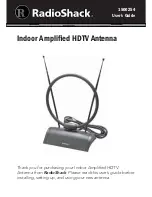
Tech Support:
www.steppir.com/support
Tel: 425.891.6134
Page 94
check the resistance of the motor windings
.
Be very careful not to short the pairs together or touch
any other pins in the process, or you can potentially damage the controller driver chips.
With the controller power plugged in, you should read approximately 3.5 VDC across each pin pair. At this
point, change bands using the controllers band change button. As an example, switching from 20m to 10m
generally gives a long enough run to get a good reading. You should be reading on your volt-ohm meter
approximately 20 to 25 VAC using a 24 volt power supply. To check the next pin pair, you can then change
bands back to 20m and so on through the wire pairs. If you have significantly different values at any point
in the test process, you can be reasonably certain that you have a damaged driver chip for that element.
Please be aware that in some cases, we have seen driver chips partially damaged, causing them to work
part of the time. This can be confusing in the test process.
If you do not have the optional 25 pin dSub splice assembly (see
Chapter Five, Section 5.2
) when measur-
ing the voltages, a suggestion would be to use a bare 25pin dsub to plug into the SteppIR controller and
then insert a paper clip to penetrate the pin hole. Usually about .75″ long will do the trick. One paper clip
being longer than the other also helps. Again, be careful NOT to short the pins. Even if the controller is
turned off, there is always voltage going to the pins with a SteppIR controller. We do this to “lock” the step-
per motors, and minimize the need to calibrate the antenna on a regular basis.
There is a defective coax jumper cable from the coax switch relay box output to the Director or
the Reflector
—our coax jumpers are manufactured by a company that specializes in these products, so a
defective jumper is relatively rare, but it has happened.
To check the coax jumper cable, measure the
resistance between the center conductor of the PL-259 on the each end of the coax. The coax jumper
should measure a very low resistance of 3 ohms or less (has continuity). If the coax jumper has high
resistance (no continuity), there is likely a problem with it.
There is a defective relay inside the coax switch box
— relays are mechanical devices so there is al-
ways a chance one could be defective, although we test all coax switch boxes before they leave the factory.
Refer to
page 51-53
for the relay test instructions.
The coax relay box is not switching due to a defective relay or the relay switching voltage is
somehow not getting to the relays—
this could be due to a defective control cable, a broken wire or a
defective controller relay board. Refer to
page 51-53
for the relay test instructions.
The Director or Reflector element is not tuning, or tuning intermittently
—This could be a defective
control cable, controller driver chip or a defective EHU. If you have already tested for these potential issues
and to verify if the EHU is actually tuning, follow these steps:
1. Go to "Create/Modify" in setup mode and apply enough power to get a good SWR reading.
2. Select the Reflector element and change its length about 15-inches and see if you see a difference in
SWR. It doesn't matter if the SWR improves or gets worse as long as it changes. This indicates the ele-
ment is tuning.
3. Select the Director element and repeat the above steps. If the SWR changes the element is moving.
If the EHU looks like it is not moving and you have already done all of the wiring checks in this section, con-
tact our technical support department for further instructions.
CHAPTER SIXTEEN
SECTION 16.0
TROUBLESHOOTING THE DB42 YAGI
TROUBLESHOOTING TIPS





































